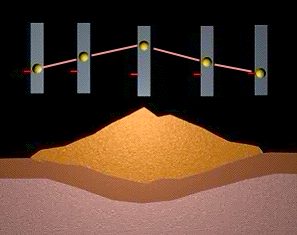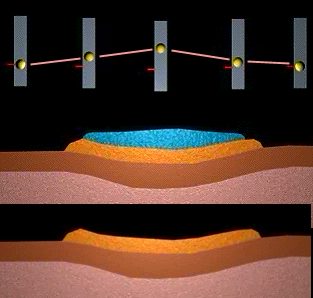
The S- wave, P wave combination show an outer liquid area and solid inner core. Apparently just below the mantle, the pressure temperature curve favors molten iron and at about 5350 km the pressure wins out and the material solidifies.
Lithosphere

Continental Rock

Areas over old ice sheets
There is an instrument called a "gravimeter" which can measure very small differences in gravity.
First, gravity is directly related to the MASS of an object. The more mass, the more gravitational pull. Hence a 1" diameter iron sphere has more gravitational pull than 1" ice sphere.
The gravitational pull over the earths surface is not a constant. Therefore the material (rock) between the measurer and the center of the earth must be different in these locations.
One might expect there to be higher gravity at the top of a mountain than near the sea shore as there is far more rock under the mountain. (This is, however, not always the case!) Since gravity is directly related to the density of the rock (mass), the type of rock plays an important role.
Continental rock is less dense than mantle rock, and as it happens, the Principle of Isostacy plays a pivotal role. A mountain has more continental rock under it, but it displaces mantle rock as it sags into the mantle. Hence, the thickness is higher, but it is made up of less dense rock. The gravimeter can actually shows less gravity above a mountain.
Remember the glacial ice sheets. They too depress the lithosphere and hence move more material out of the way. Measurements above the ice sheets or where there used to be ice sheets both show lower gravity readings. This is due to the slow rebound of the depressed areas. It takes time for the asthenosphere to "flow" back in and refill the voided area.
The "take home message" from all of this is that the Lithosphere "floats" on the asthenosphere, and will eventually achieve isostatic equilibrium.
| NEXT | TOC | PREV |